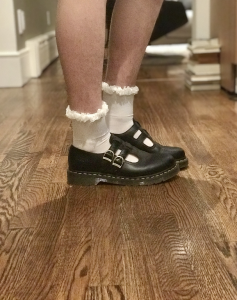
by admin
Wearing the Pants, and the Dress as Well

A photo the author, Julia Clardy, took of her legs.
When I showed a girl in my class the prom dress I was thinking about buying, the first thing she asked me was whether or not I was going to shave for prom. Her question wasn’t really that surprising. People often associate body hair with uncleanliness, and they don’t expect it to appear in formal situations. The fact is, people only question me about my body hair when I’m wearing something more traditionally feminine. When I’m wearing shorts and a t-shirt people rarely look twice at my legs or armpits, but when I’m wearing a dress, people consistently double-take. When it comes to how other people see me, it seems that my casual clothes and body hair make more sense together than my more feminine clothes and body hair.
I’ve always been passionate about clothes. I’ve cycled through many fashion phases in my life. For a while in eighth grade I sported a lot of ill-advised Zooey Deschanel inspired looks, but by sophomore year of high school I cut my hair short and wore baggy jeans and fisherman sweaters. No matter what I wore, I never felt unfeminine. Femininity is something inside me, and, for me personally, it’s not tied to my choice of clothes or my decision to shave or not. Regardless of my presentation, I feel like a woman because that is how I identify.
Fashion has always been an incredible tool by which to measure and enact change. 1960’s America saw a total fashion revolution. The shorter hemlines and bold patterns anticipated many of the social changes occurring during that time. Today, fashion and feminism may seem more intertwined than ever before. Feminist apparel is widely popular and has made its way to the runway. For instance, there was a “We Should All Be Feminists” T-shirt in the Dior runway show. While this exposure of feminist ideals and lingo is fabulous, many are concerned that this is turning feminism into a “trend.” While I understand the concern that big brands are using feminism as a marketing tool, I am uneasy about the insinuation that because fashion is incorporating these feminist ideas, the ideas are being cheapened or turned into a frivolity.
Taking the example of feminist apparel, fashion is both a tool we can use to voice our beliefs, and also often presents double standards that are unfair to people of all genders. I shift back and forth between wearing more “masculine” and more “feminine” clothing. Women in our society today are widely accepted when they choose to wear more “masculine” clothing, like pants, for instance. This same ideology does not work in the reverse, as men wearing more “feminine” clothing, like dresses, are stigmatized and discriminated against. This behavior stems from the general idea that, as a man, it’s unfavorable to appear feminine. This binary approach makes it seem like fashion and feminism are not compatible. However, this is completely untrue, as fashion has been and continues to be a tool for women’s liberation. The way in which society decides if someone is masculine or feminine based on dress is oppressive—not fashion itself.
Nobody should be expected to uphold any kind of continuity in how they dress. Fashion is an incredibly powerful tool for self-expression, and it should be exercised to whatever extent the wearer finds appropriate. If someone wants to shave their head and wear a full face of makeup every day, that doesn’t make them any more or less of a woman or a feminist. In the same way, whether or not I shave for prom, I’m still gonna look like a badass woman in my dress, tearing it up on the dance floor with my friends.
This article was originally published on Jewish Women, Amplified, the blog of the Jewish Women’s Archive, and was written as part of the Rising Voices Fellowship.
The views and opinions expressed in this article are the author’s own and do not necessarily reflect those of Lilith Magazine.